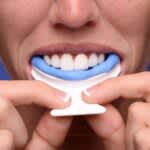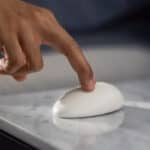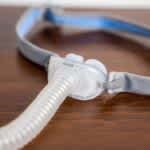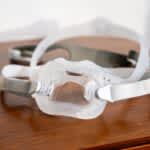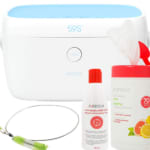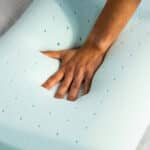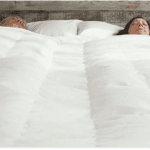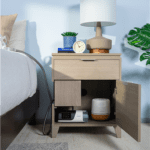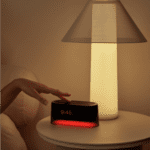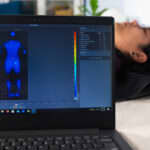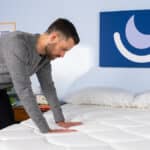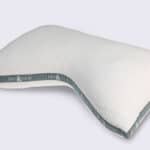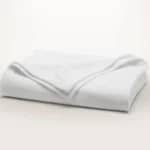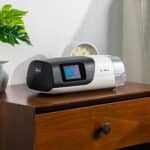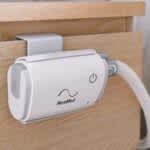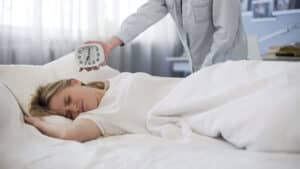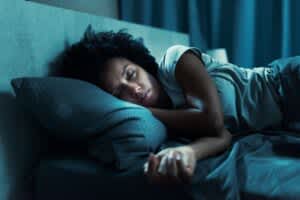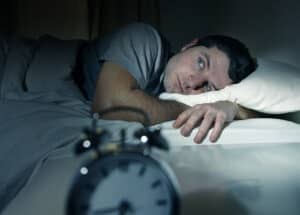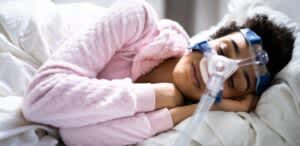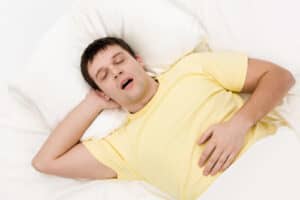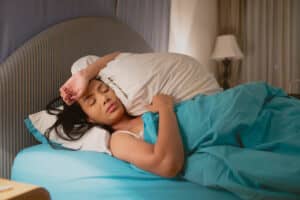Medical Disclaimer: The following content should not be used as medical advice or as a recommendation for any specific supplement or medication. It is important to consult your health care provider prior to starting a new medication or altering your current dosage.
While it may seem straightforward, breathing is controlled by a complex network of organs in the body. Breathing can be intentional, but it also continues without effort while people are sleeping or unconscious.
Sleep-related breathing disorders are medical conditions in which a person’s breathing becomes abnormal when they sleep. We’ll discuss the forms of sleep-disordered breathing as well as the major risk factors, most common symptoms, and treatments. We will also cover how health experts diagnose this unique group of sleep disorders.
What Is Sleep-Disordered Breathing?
Sleep-disordered breathing involves problems or abnormalities with respiration during sleep, some of which can be classified as sleep disorders. In some cases, these breathing issues may also persist during the day.
Both adults and children can experience sleep-disordered breathing. Nighttime breathing problems are important to address because they can disrupt a person’s sleep and lead to daytime sleepiness. Sleep-disordered breathing can also increase the risk of health complications such as cardiovascular problems.
Types of Sleep-Disordered Breathing
Sleep-related breathing disorders fall into four main categories based on each condition’s causes and symptoms:
- Obstructive sleep apnea disorders
- Central sleep apnea syndromes
- Sleep-related hypoventilation disorders
- Sleep-related hypoxemia disorder
Other forms of sleep-disordered breathing don’t qualify as sleep disorders. These include snoring and catathrenia, which is also called sleep-related groaning.
Obstructive Sleep Apnea
The most common form of sleep-disordered breathing, obstructive sleep apnea (OSA) occurs when the upper airway collapses and becomes physically blocked during sleep. Between 10% and 30% of adults have obstructive sleep apnea. Less commonly, children can also be diagnosed with this condition.
Blockages in the upper airway during sleep can lead to either complete or partial pauses in breathing. Episodes of obstructive sleep apnea can temporarily reduce blood oxygen levels, cause a person to wake up repeatedly at night, and contribute to a wide variety of health complications.
Central Sleep Apnea
As with OSA, central sleep apnea (CSA) causes breathing to partially or completely stop during sleep. Central sleep apnea happens when the brain doesn’t properly signal the muscles that control breathing. CSA is far less common than OSA, affecting less than 1% of people.
Central sleep apnea is usually caused by another medical issue. Most people with central sleep apnea have heart failure, though this type of sleep-disordered breathing can also occur in people who have had a stroke or are taking opioids.
Sleep-Related Hypoventilation Disorders
Hypoventilation refers to breathing that is not fast enough or deep enough. In sleep-related hypoventilation disorders, slow or shallow breathing begins or gets worse at night, resulting in an unhealthy level of carbon dioxide in the bloodstream.
There are several types of sleep-related hypoventilation disorders related to various underlying causes. These disorders may be caused by obesity or another medical issue, medication, substance abuse, or a rare genetic mutation.
Sleep-Related Hypoxemia Disorder
Sleep-related hypoxemia disorder may be diagnosed when a person has low oxygen levels while sleeping that cannot be explained by another type of sleep-disordered breathing.
This disorder is usually associated with one or more underlying medical conditions, including lung disorders and conditions affecting the nervous system.
Snoring and Catathrenia
Snoring and catathrenia are forms of sleep-disordered breathing that may be normal or symptoms of a disorder. By themselves, they don’t meet the criteria to be considered sleep-related breathing disorders.
Snoring is a sound made by tissues of the upper airway vibrating during nighttime breathing. Almost everyone snores occasionally. Frequent snoring may disrupt a sleep partner, while loud or persistent snoring can indicate a more severe breathing disorder.
Catathrenia refers to groaning or moaning during sleep. Medical experts still do not know if this rare condition causes any long-term health consequences. While sleepers are often unaware of their catathrenia, frequent groaning at night may disturb a bed partner’s sleep.
What Are the Symptoms of Sleep-Disordered Breathing?
The most common symptoms of sleep-disordered breathing include heavy snoring, fitful or nonrestorative sleep, and daytime sleepiness or fatigue. Some symptoms occur during sleep, while others appear during the day.
Nighttime Symptoms
Nighttime symptoms of sleep-disordered breathing involve changes to a person’s normal breathing patterns and the quality of their sleep.
- Severe Snoring: Snoring isn’t always a problem. But loud, frequent snoring is a hallmark symptom of obstructive sleep apnea. People with other forms of sleep-disordered breathing, like central sleep apnea and sleep-related hypoventilation disorders, may also snore.
- Restless Sleep: Many types of sleep-disordered breathing lead to restless, poor-quality sleep.
- Interrupted Breathing: People with sleep apnea often breathe in starts and stops, sounding like periods of silence punctuated by bursts of loud snoring. Health experts call these reductions and pauses in breathing hypopneas and apneas.
- Fast, Slow, or Shallow Breathing: Sleep-related hypoventilation disorders are associated with breathing that is slow and shallow. Some forms of central sleep apnea involve cycles of rapid breathing followed by apneas or hypopneas.
Daytime Symptoms
People with sleep-disordered breathing are often sleepy during the day. This is because impaired breathing at night can disrupt sleep, leading to poor sleep quality and daytime fatigue.
In sleep apnea, breathing interruptions are isolated to periods of sleep. But other forms of sleep-disordered breathing can manifest during the day as well as the night. For example, people with sleep-related hypoventilation can have increased carbon dioxide levels during the day.
What Are the Risk Factors for Sleep-Disordered Breathing?
Several factors can increase a person’s risk of sleep-related breathing problems, including age, sex, weight, and certain medications.
- Age: Older adults are more prone to some types of sleep-disordered breathing. Snoring tends to be more common among older adults. People in their 60s and 70s are also more likely to have sleep apnea.
- Obesity: Not every person with obesity has disordered breathing when they sleep. But obesity increases the risk for several types of sleep-disordered breathing, including obstructive sleep apnea and hypoventilation disorders. Overweight people are also more likely to snore.
- Sex: Males are more likely to develop sleep apnea, which researchers suspect may be related to testosterone’s effects on breathing. This risk may also apply to transgender people undergoing gender-affirming hormone therapy, although more research is needed.
- Health Conditions: Besides obesity, certain other health conditions can increase the risk of sleep-disordered breathing, including chronic obstructive pulmonary disease (COPD), heart failure, stroke, and kidney failure.
- Medications and Other Substances: Medications that contribute to sleep-disordered breathing include prescription opioids, antidepressants, and muscle relaxants. Other substances, including illegal opioids, alcohol, and smoking tobacco, can also trigger or worsen sleep-disordered breathing.
- Facial and Airway Features: Sometimes a person’s physical features can make them more likely to have sleep-related breathing problems. For example, having a smaller jaw or larger tonsils increases the chances of developing obstructive sleep apnea. Enlarged tonsils are a major risk factor for sleep apnea in children.
Treatment for Sleep-Disordered Breathing
Treatment for sleep-disordered breathing depends on the type of breathing disorder and a person’s individual needs. For many forms of sleep-disordered breathing, the goal of treatment is to restore healthy breathing patterns, reduce symptoms, and decrease the risk of health complications.
- Positive Airway Pressure (PAP) Therapy: PAP therapy is a treatment for several forms of sleep-disordered breathing. PAP therapy uses a stream of pressurized air to keep a person’s airway open while they sleep. There are several ways of delivering PAP therapy, including continuous positive airway pressure (CPAP).
- Supplemental Oxygen: Supplemental oxygen, also called oxygen therapy, increases the amount of oxygen in the blood. Supplemental oxygen may help treat both central sleep apnea and sleep-related hypoxemia.
- Oral Appliances and Surgery: Oral appliances and surgery are less common treatments, but may improve symptoms for some people who have obstructive sleep apnea.
- Nerve Stimulation: Nerve stimulation therapies use implanted medical devices to improve breathing. Hypoglossal nerve stimulation can treat some cases of obstructive sleep apnea, while phrenic nerve stimulation may be appropriate for some people with central sleep apnea.
- Medications: Treatment with medications is uncommon for sleep-disordered breathing, but may be appropriate for select people.
Some cases of sleep-disordered breathing are caused by other medical conditions. In these instances, treatments may focus on addressing the underlying condition, in addition to or instead of treating the breathing disorder directly.
Doctors may also recommend lifestyle changes, depending on the type of breathing disorder and a person’s characteristics. Common recommendations include:
- Weight loss for people who are overweight or have obesity
- Getting regular exercise during the day
- Reducing or eliminating medications and substances that worsen breathing issues
- Changing sleep position
Diagnosing Sleep-Disordered Breathing
If you have concerns about sleep-disordered breathing, talk with your doctor. They can help you better understand your symptoms and refer you to a sleep specialist if needed.
To diagnose sleep-disordered breathing, a medical professional may begin by conducting a physical exam and collecting your medical history. They may then recommend a sleep study.
Also known as polysomnography, a sleep study is an overnight medical evaluation that tracks a wide range of vital signs, including:
- Sleep stages
- Airflow
- Respiratory effort
- Blood oxygen levels
- Heart rate
This data helps your health care team monitor your breathing as you sleep. With the data collected during the sleep study, your doctor or a sleep specialist can get a better idea of your overall sleep quality, as well as the type and severity of your nightly breathing issues.
If your doctor thinks you may have obstructive sleep apnea, and if you don’t have other serious health conditions or sleep disorders, they may recommend an at-home sleep apnea test instead of an overnight sleep study.
References
The Sleep Doctor Forum: Real Experiences, Real Connections
Continue the discussion on the Sleep Doctor Forum. Connect with experts and fellow forum members on CPAP, sleep apnea, and all things sleep. A priceless resource that’s free to join.



